| Acoustics of the saxophone |
Bb tenor saxophone |
A#3 |
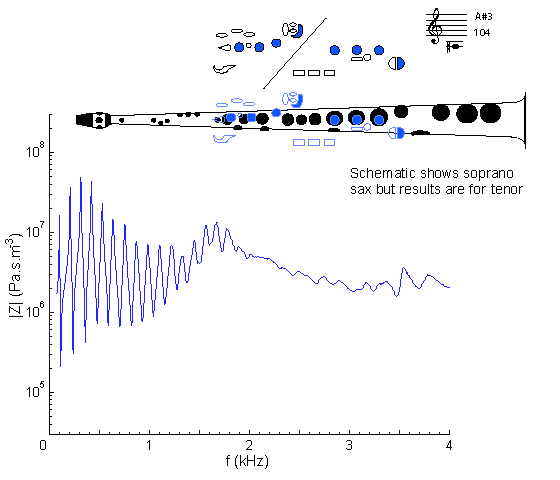
|
Fingering Acoustic schematic Non-specialist introduction
to acoustic impedance Notes are the written pitch. |
This is the lowest note on this saxophone. All tone holes are closed, so the sax most closely resembles a conical pipe. The maxima fall at frequencies in approximately harmonic series: frequencies f, 2f, 3f etc. (For a detailed explanation and comparison of conical and cylindrical closed and open pipes, see Pipes and harmonics.) As a result, the regular series of maxima (and minima) in Z(f) extends to high frequencies.
The maxima (and minima) become weaker at high frequencies for several reasons: first, the loss of energy where the moving air is close to the walls is more important at high frequency. Second, the bell radiates high frequencies better than low, so there is less reflection of high frequencies and so weaker resonances. This is due to the conical shape. For a simplified explanation, and to understand how the bell and the mouthpiece contribute to the shape of this curve, see frequency response and acoustic impedance in Saxophone acoustics. At very high frequencies, the conical shape and the bell radiate so well – rather like a megaphone – that there is very little reflection and so no resonances and no impedance peaks.
The first several maxima can be played – it's called bugling: the resonance associated with each peak drives the reed. However, the first maximum is more difficult to play than the next, especially when playing softly. Loud notes have disproportionately more contribution from high harmonics, and the high harmonics of the lowest note match impedance peaks, while a soft note has less 'help' from higher harmonics.
Compare with the impedance spectrum for a soprano sax on written A#3: same fingering but sounding one octave higher. The soprano also has a larger cone angle than does the tenor.
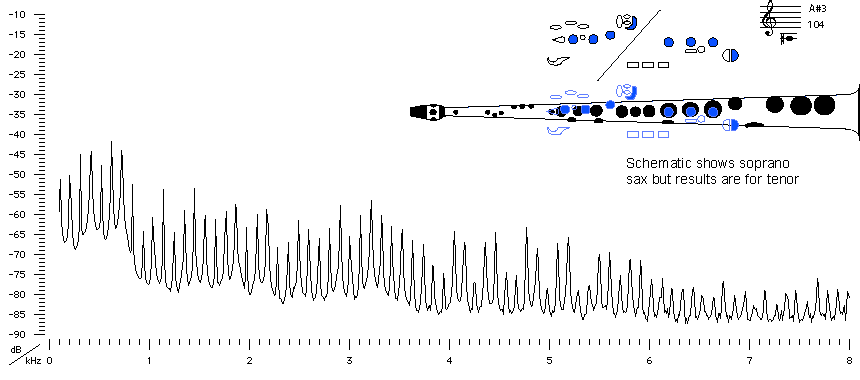
Sound spectrum
of a Bb tenor saxophone
played using fingering for A#3.
For more explanation, see
Introduction to saxophone acoustics.
For this note, we show spectra for different loudness or dynamic level (ff, mf, mp and pp). Note that the main distinguishing feature of a loud note is that more high harmonics appear and that the harmonics already present become stronger. The more and stronger harmonics change the timbre of the sound, making it brighter or less mellow: listen to the sound files. They are also very effective at making it louder, because our ears are most sensitive in the range 1-4 kHz. (See What is a decibel?) Note also that the base line for all spectra is a broad band 'noise' containing all frequencies. This is due to the turbulence of air passing through the reed opening, and it is an important part of the characteristic saxophone sound, particularly at the beginning of a note, or when playing low and softly.
The peaks in the sound spectrum are harmonics: they fall at frequencies f0, 2f0, 3f0, etc. This is only approximately true of the peaks in the impedance spectrum, and some impedance peaks no longer coincide exactly with the sounding harmonics. The width of the harmonic peaks is determined by the frame size of the Fourier transform, and not (for this note) by vibrato.
In the sound spectra for the low notes, we can notice a sudden increase in the negative slope of the spectral envelope that occurs close to the cut-off frequency of about 800 Hz.
For a discussion of how the reed motion produces different timbre and dynamic levels, see Playing softly and loudly.
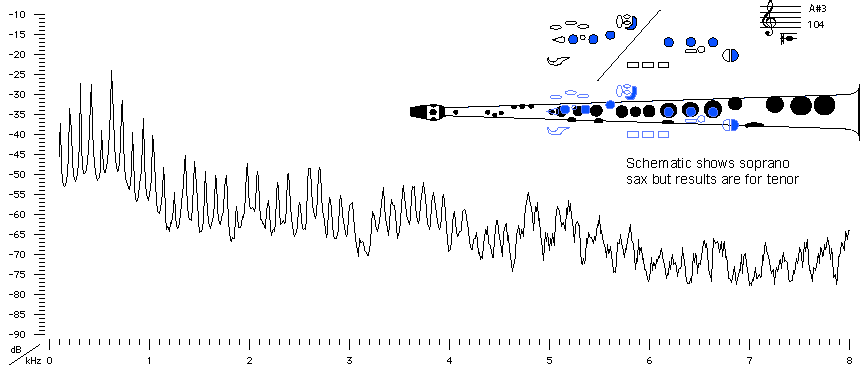
Sound spectrum of a Bb tenor saxophone played using fingering for A#3 fortissimo.
![]()
![]() You can hear A#3 fortissimo played on a Bb tenor saxophone.
You can hear A#3 fortissimo played on a Bb tenor saxophone.
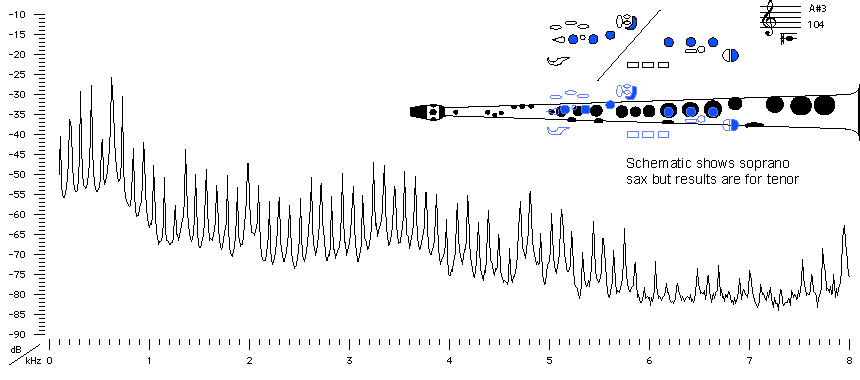
Sound spectrum of a Bb tenor saxophone played using fingering for A#3 mezzoforte.
![]()
![]() You can hear A#3 mezzoforte played on a Bb tenor saxophone.
You can hear A#3 mezzoforte played on a Bb tenor saxophone.
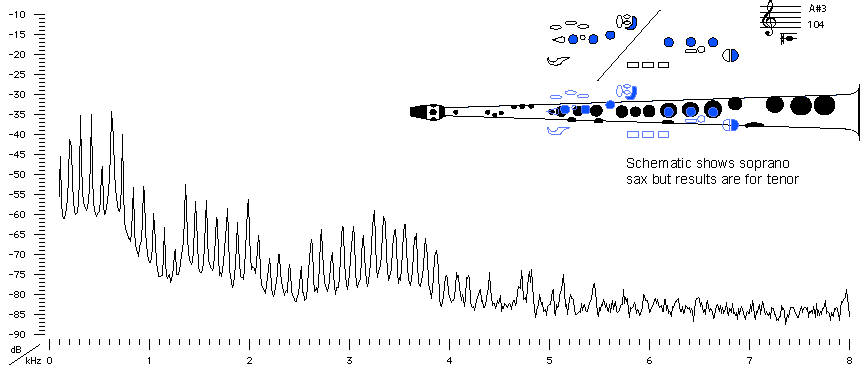
Sound spectrum of a Bb tenor saxophone played using fingering for A#3 mezzopiano.
![]()
![]() You can hear A#3 mezzopiano played on a Bb tenor saxophone.
You can hear A#3 mezzopiano played on a Bb tenor saxophone.

Sound spectrum of a Bb tenor saxophone played using fingering for A#3 pianissimo.
For more explanation, see Introduction
to saxophone acoustics
![]()
![]() You can hear A#3 pianissimo played on a Bb tenor saxophone.
You can hear A#3 pianissimo played on a Bb tenor saxophone.
|
Contact:
Joe Wolfe
/ J.Wolfe@unsw.edu.au |